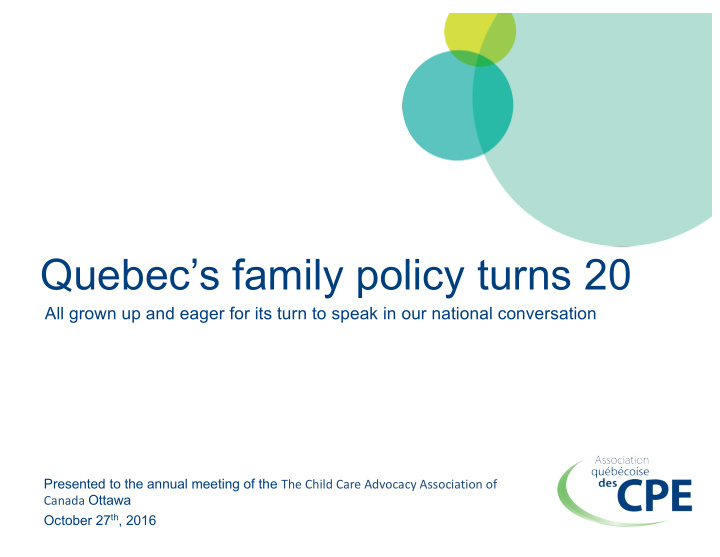



Quebec’s family policy turns 20 All grown up and eager for its turn to speak in our national conversation Presented to the annual meeting of the The Child Care Advocacy Association of Canada Ottawa October 27 th , 2016
AQCPE: Our Mission We are a network of non-profit businesses that are part of the social economy and we represent a majority of Quebec’s Centres de la petite enfance (CPEs). We are Quebec’s leading voice on all early childhood-related issues. 2
Quebec’s Family Policy: A Brief Reminder • Born in 1996, from a broad-based economic summit aimed at stimulating boosting employment and stimulating economy; • Created by a government that had pledged a balanced budget; • Seeks to promote economic development by helping families to balance work and family AND by promoting equal access to high-quality educational daycare services, thus promoting equality of chances. 3
Highs and Lows of the Family Policy Victim of its own success! 4
A Steady Financial Erosion of the Family Policy In the past decade, Quebec’s CPE program has been subjected to: • More than $500-million in funding cuts; • Numerous government decisions aimed at slowing down its development; • In parallel, successive governments have boosted the development of a parallel, for-profit network of private daycares that are funded by tax credits; • Inevitably, quality will suffer in this race to the bottom. 5
Highs and Lows of the Family Policy The development of places in the different types of daycare centres: A clear indicator of the government policy direction. For-profit For-profit subsidized non 24 740 subsidized 1 620 2003 CPE 63 339 Home daycare 75 355 6
Highs and Lows of the Family Policy The development of places in the different types of daycare centres: A clear indicator of the government policy direction. For-profit non subsidized 56 821 CPE 92 687 2016 For-profit subsidized 46 498 Home daycare 91 604 7
Highs and Lows of the Family Policy Budget Plan 2008-2009 5 000 places in for-profit non subsidized daycare centres (FPNS) 45 000 places at the election in 2014 + Freeze of the development of new places in CPE + New tax measures pushing parents towards for-profit daycare centres, including increase + modulation of subsidized services + Development project des CPE -> 50 % of the capital costs + 500 M$-cuts in CPE between 2003 and 2016 56 821 places in June 2016 Still missing 36 000 places to get to 93 000 8
A Craze For Chains of Childcare Centres? A golden business model : ü Garanteed clients ü « Public » financing (tax credits) Home daycare FPS FPNS CPE 32% Number of places 32% 15% 19% CPE Complaints FPNS 53% FPS 34% 14% * The complaints about home daycare centres that are received at the Ministry are not representative of reality because almost all of the complaints are treated up-front in the Coordination Offices. 9
Citizens’ Protests to Save the Network The development of places in the different types of daycare centres: A clear indicator of the government policy direction. 10 10
Equality of Chances : A Forgotten Concept? All children must have the same chances in life, whatever their social status. 11
Our Project : An independant travelling commission A public conversation about early childhood education • The AQCPE plans to create a travelling commission to stimulate discussion of this issue throughout Québec. • This commission, made up of members of the public, will be independent and apolitical, as well as scientific in its approach. • The scope of these public consultations will include: accessibility, universality, quality of services, equality of chances. • The commission’s report will lay the basis for a wider conversation that will culminate with a summit in Montreal in June 2017. • National and international experts and stakeholders will be invited to take part in the event, which will lead to the publication of a white paper that will be presented to Quebec’s National Assembly. 12
Our Goals • Ignite a national conversation; • Make the debate on childcare educational services unavoidable; • Gather public support of important stakeholders; • Make room for science in the debate; • Steer public policy. 13
Thank you 14
Recommend
More recommend